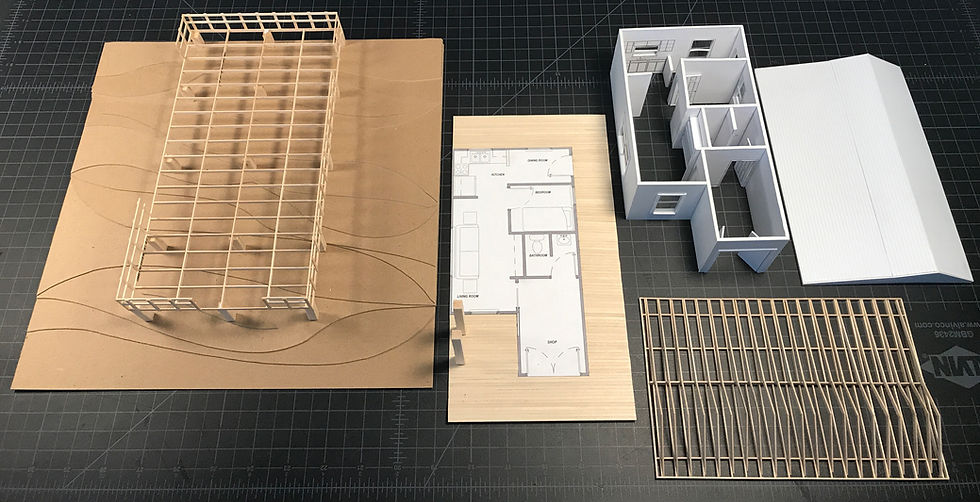Essential Books for Set Design
- Konstantin Sumtsev

- Feb 16, 2019
- 4 min read
Books are no doubt the greatest source of knowledge we have available to us. One can't have enough of them in your library, especially in the field of Set Design, since each project you embark on is a new story. You soon discover the importance of reference material as an aid to accurately and consistently deliver on that story. Whatever that story is: a New York City Manhattan Art Deco apartment set in the 1930's to a small contemporary coastal town beach house. Each project presents itself with a particular architectural style, details, form, space, history, and the addition of unique character(s) that might have altered the typical conventions over the years of living there.
Books allow us to study the past and its experiences, ventures, accomplishments from which much can be learned and mirrored in our work. Like most things in life, it's a trial and error and often times you learn more from the failures than successes. In the De Architectura (published as Ten Books on Architecture) (Book 1) by Marcus Vitruvius Pollio, (30 - 15 BC), translated by Morris Hicky Morgan, "The architect should be equipped with knowledge of many branches of study and varied kinds of learning, for it is by his judgement that all work done by the other arts is put to test. This knowledge is the child of practice and theory. Practice is the continuous and regular exercise of employment where manual work is done with any necessary material according to the design of a drawing. Theory, on the other hand, is the ability to demonstrate and explain the productions of dexterity on the principles of proportion." While books provide the knowledge and theory, one still needs to implement/practice it in the daily work and improve upon it when necessary. As I personally continue my journey in becoming a more experienced Set Designer, I wanted to share with you the books that I feel are a good foundation to start with and are my daily go-to references.
Feel free to comment below if you have any thoughts or recommendations for other books!

Julius Panero & Martin Zelnik, Human Dimension & Interior Space: A Source Book of Design Reference Standards, (1979) -- Great reference book in the aid of designing spaces with regard to the human form.
Patricia Woodbridge & Hal Time, Designer Drafting and Visualizing for the Entertainment World, 2nd Edition, (2012) -- This was my University textbook that gives a great introduction to principles, conventions, and rules for drafting / communicating specifically geared towards the entertainment industry. It covers the importance of survey (which I will also cover in a different blog post) and 3D modeling.
Francis D.K. Ching, Building Construction Illustrated, 5th Edition, (2014) -- The title says it all. A go-to book for me as it helps me understand building construction and how I can modify elements while keeping to the standards for the purpose of designing sets. Includes great illustrations and dimensional standards.
Francis D.K. Ching, Architecture: Form, Space, and Order, 4th Edition, (2014) -- Another amazing book by Ching. In fact if I had all of the books that he published I would probably recommend all of them. Easy and simple to understand with many historical / contemporary examples to illustrate the points.
Julia McMorrough, The Architecture Reference & Specification Book, (2018) -- A quick reference guide that I keep on my desk for simple detailing / common measurements and terminology.
S.C. Reznikoff, Interior Graphic and Design Standards, 1st Edition, (1986) -- A fantastic reference book for everything to do with interior design standards. A must buy in my opinion.
American Institute of Architects and Dennis J. Hall, Architectural Graphic Standards, 10th Edition, (2010) -- Another fantastic reference book for everything to do with architectural standards, as the name implies. This book has just about everything you need and then some. It is so comprehensive that I barely ever need to look up anything online to supplement the text. Make sure to get the 10th Edition-the future editions have reorganized the book in a way that makes it a bit challenging to find what your looking for. This one is also a must buy.
Francis D.K. Ching, A Visual Dictionary of Architecture, 2nd Edition, (2011) -- Excellent architectural dictionary. Great reference for terminology.
Stephen Calloway, The Elements of Style: A Practical Encyclopedia of Interior Architectural Details from 1486 to the Present, (1997) -- Great reference to the architectural details/styles throughout the decades in North America. In Set Design we don't often create contemporary spaces and this is a good place to start for design consistency and accuracy.
Bill Raoul & Mike Monson, Stock Scenery Construction Handbook, (2015) -- Good introduction / reference for construction of sets in both film and theater.
Dennis Dorn & Mark Shanda, Drafting for the Theater, (2012) -- Similar to Designer Drafting and Visualizing for the Entertainment World this book concentrates on the specifics of theater. However, I reference this as elements of theatrical sets can be applied to film.
Rich Rose, Drafting Scenery for Theater, Film and Television, (1990) -- A good book on the technical side of drafting and its conventions.
Francis D.K. Ching, Architectural Graphics, (1987) -- Another good book on the drafting conventions.
Criss B. Mills, Designing with Models: A Study Guide to Making and Using Architectural Design Models, (2005) -- A good guide to model making. Although a bit dated and lacks information on rapid prototyping (3D & SLA Printing) and 3D modeling. That being said, the essence and importance of model making techniques are still very relevant.
Marguerite L. Koepke, Model Graphics: Building and Using Study Models, (1988) -- Another guide to model making. Great tips and tricks as well as processes.



Comments